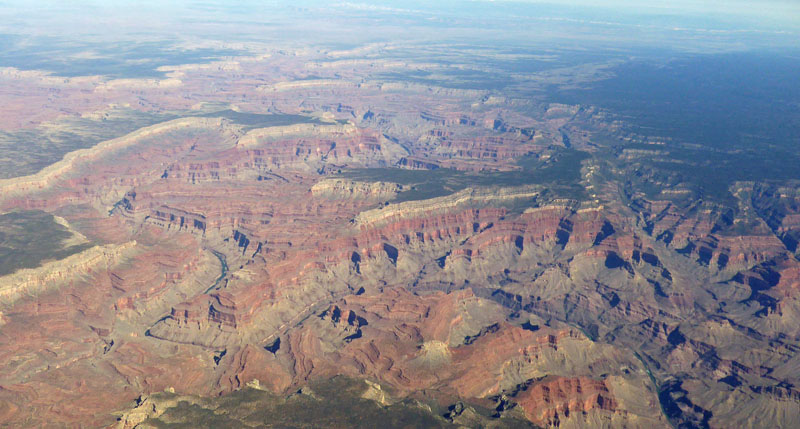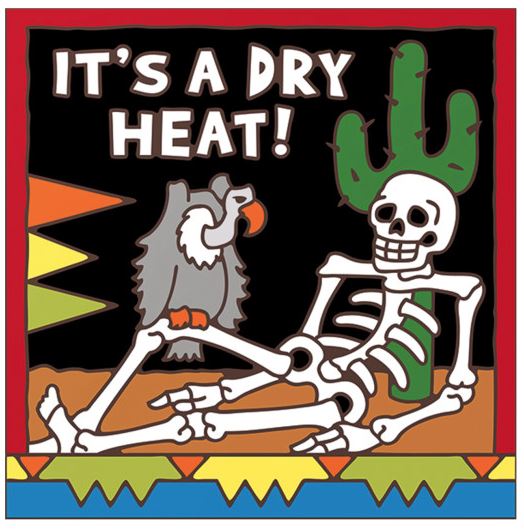
As I hurtled up the hill at 100 miles an hour towards the 180°, high-g Corner 3, on the far side of which was an abrupt drop-off, I began to wonder if I'd made a big mistake!
When I registered that morning, they informed me that the damage deductible for any car I'd be driving was $8,000 although my existing policy covered me for the car we rented in Las Vegas, coverage for any cars I drove ended at the race track but for $200 I could reduce the deductible to $2,000.
I thought it unlikely that I'd need to pay any deductible, but that was before I learned that we wouldn't be fully protected by the traction control and automatic stability control that are in effect in the Tour Mode that I normally choose. Theyd be switching us past Sports to Track Mode, and selecting a level that dialed back their effectiveness. If we made mistakes, they wanted to see them so they could be corrected, they said!
It was also before the unexpected downpour, about which they casually remarked, "Oh, we race in the rain!"
And it was also before one of our driving sessions was cut short so they could attend to a car that had gone off the course. If we hadn't been in one of the groups on the track at that time, we wouldn't have known about it and there were three other groups about whom we knew nothing.
But I'm getting ahead of myself.
After having to cancel our trip last fall at the last minute, I checked the average temperature charts for Las Vegas, where we would be spending five days before the class and two days afterwards and found that the end of April seemed to be about the same as the end of September, so I signed up for the April 30 to May 1st class.
So much for the charts! After our arrival, temperatures increased 10° above normal, over 100° some days.
But, after all

After the course ended, we returned Tuesday afternoon during a downpour, and the temperatures dropped into the 50s. TV newscasts featured dismayed day-trippers in shorts and flip flops on nearby Mount Charleston who were unprepared for a sudden snowfall. The inclement weather also thwarted our plans of visiting the Grand Canyon.1
After five days in Las Vegas, we rented a car Sunday and headed out to Spring Mountain Motorsports, detouring to cruise the 13-mile Scenic Drive through Red Rock Canyon. Arriving there around noon, we joined a long line, or rather two, inching forward. I hadn't considered that this would be a popular Sunday outing.
The wait did provide the opportunity to chat with an adjacent driver in a red Stingray convertible like mine. Or rather almost like mine his was the 650 hp Z06. I soon realized that he was a member of a group of automotive enthusiasts, followed by a Mustang GT and preceded by an exotic BMW i8.

In case you wondered, this isn't my photo. 
Fortunately, even though it's a federal, not national, park, our Seniors Lifetime Park pass provided free entry. Once in the park, traffic thinned out, aided by stops at various viewing sites.
Today's dramatic landscape has evolved over the millennia, beginning some 600 million years ago with limestone cliffs being formed on the seabed the land once occupied. After faults and volcanic action raised the land, deposition by streams and in swamp environments resulted in the formation of petrified wood.
After the climate changed, the region was buried in sand dunes up to half a mile thick, which was consolidated into red sandstone. A final, to date, massive fault action shifted and folded the rock landscape, interlacing limestone and sandstone cliffs and forming rugged canyons punctuated by waterfalls, streams, and pools.
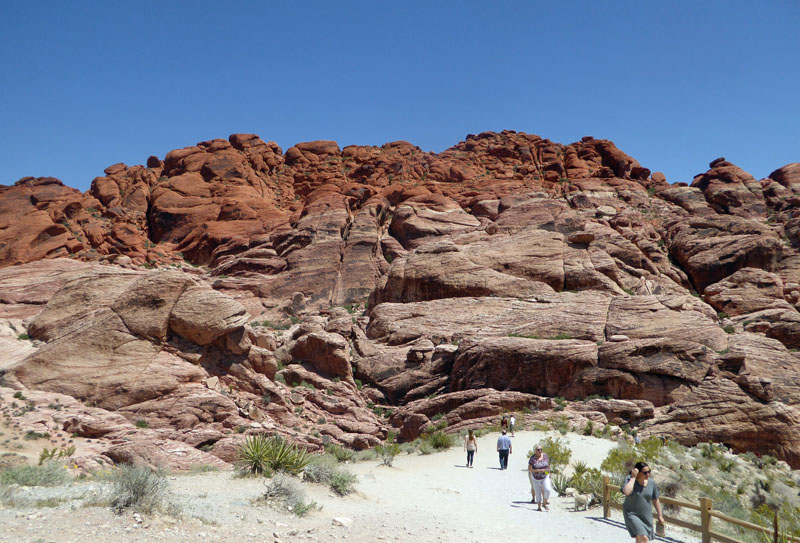
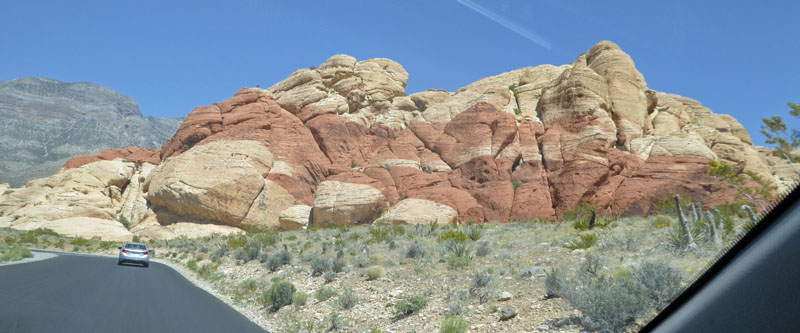
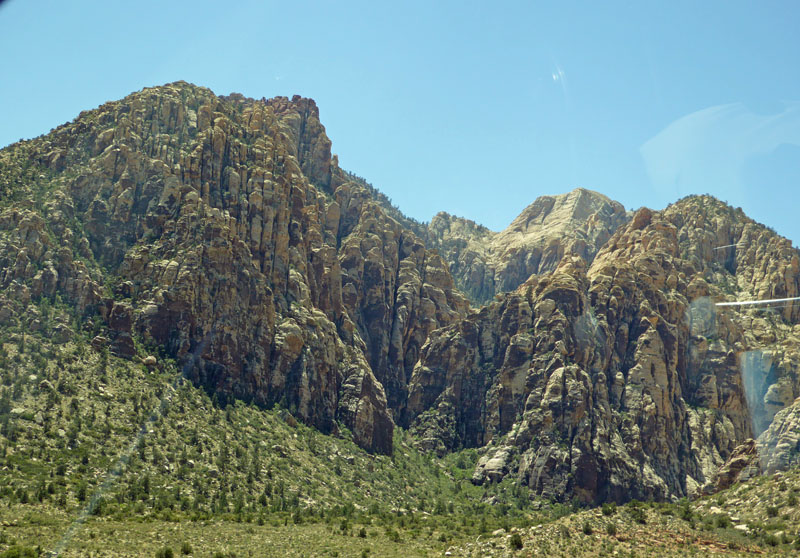
When we arrived at the Spring Mountain gate, they checked their records, found that I had been assigned to the "white" group the other two being red and blue, and installed white wristbands that we could display to avoid further formalities each time we entered.
Since check-in time was still some time away, they recommended Mom's Diner in Pahrump for a late lunch. It had a small-town, friendly feel, with waitresses who called you "dearie" and "hon," serving delicious, and ample, portions. An unusual sight for out-of-towners like us was a Native American waiter with a braid on each side and others mingling with their Caucasian neighbors and relatives.
The cashier, who was also the owner, recognized my white wristband. He was a car fan himself, as I might have guessed since I'd visited the men's room whose walls were covered with pictures of classic, antique, and hot rod cars, and we compared favorites from over the years.
Unfortunately, the attraction that is Pahrump's main claim to fame was too far off the beaten track for us to visit before we had to return to check in to our condo. The track is obviously the important part of the complex, as we discovered when we headed for our condo on the other side of it, which was in active use by an Audi club.
That is, closed surface-level gates blocked the road, requiring us to use a tunnel that ran underneath. However, they had rather shortsightedly made it only one lane wide, requiring gatekeepers at each end to coordinate traffic flow.
As we approached the condos, we thought it rather strange that the units were all on the second level the first level actually housed garages for enthusiasts who wished to keep their cars convenient to the race track!
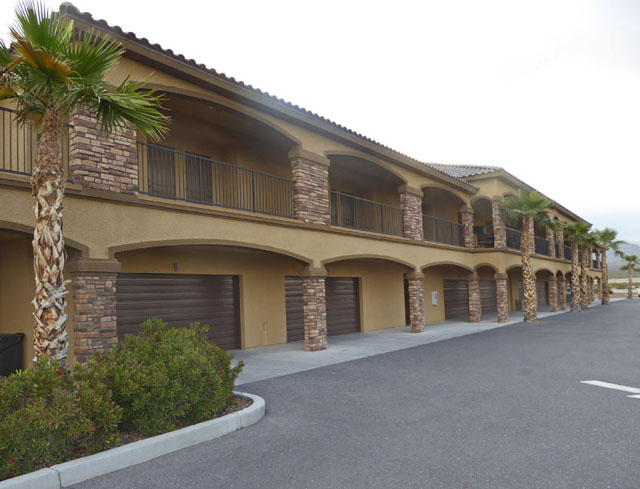
The facility includes a country club, so we once more dove under the track and checked out the clubhouse. Unfortunately, there were no services available on a Sunday, but we did meet a former student there, who was so impressed that he had joined the country club. I asked where he was from, and he said, "Albuquerque." The map wasn't firmly in my mind so I asked how far that was "621 miles!" It was hard for me to visualize the equivalence of my joining a country club in Atlanta!
Not to mention one that had a $60,000 initiation fee and $6,000 annual dues! I keep forgetting that the average Corvette owner is probably in a much higher income bracket than I am. It took me 50 years after my first car purchase also a Chevrolet, but a nondescript, well-used 1952 sedan that cost $50 to afford one. And I kept that C6 Corvette for nine years before buying the current C7 one.
However, distances may be seen differently in the wide-open spaces out West. We later met a couple of guys who would be taking the course that drove their Corvettes from Salt Lake City, some 475 miles away. The lead car had a full complement of radar and laser detectors and jammers and they had averaged over 100 mph! It did give me nostalgia for the Autobahn when we lived in Germany.
If we had been able to attend the previous fall course, we would have had more opportunity to meet and get to know the other attendees in our class, all of whom had purchased Corvettes from Mike Furman at Criswell Chevrolet in Gaithersburg, Maryland. He hadn't even met 80% of his buyers, having sold them over the phone. (He recently sold his 4,000th Corvette!)
He had enough influence to arrange a pizza party and have the bar opened while attendees watched a football game on the large-screen TVs. As it was, we were able to meet only a handful of other students during the breakfast and lunch that was served there, the Happy Hour Monday evening, and during spare moments between classroom and driving sessions.
There were rows and rows of Ron Fellows Corvettes parked all over 150 in all, we were told.
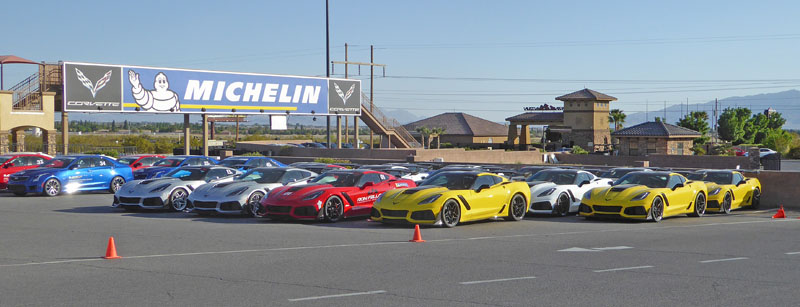
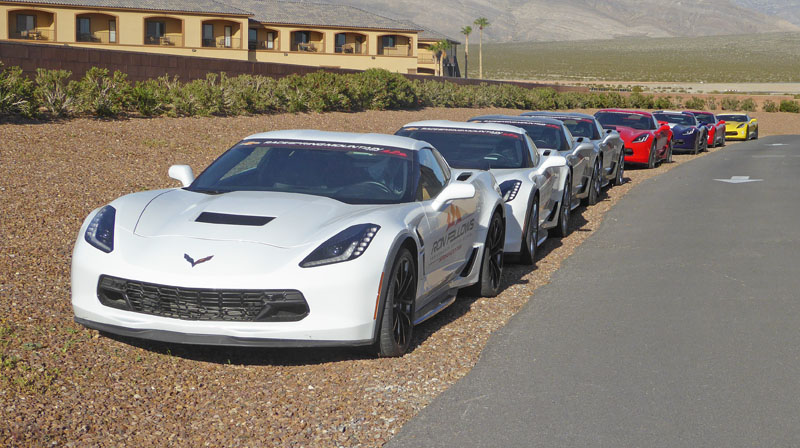
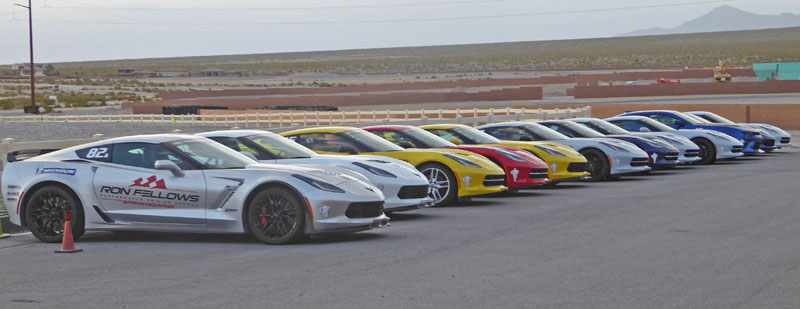
Each of the three venues had 35; one for each student, each instructor's lead car, and spares.
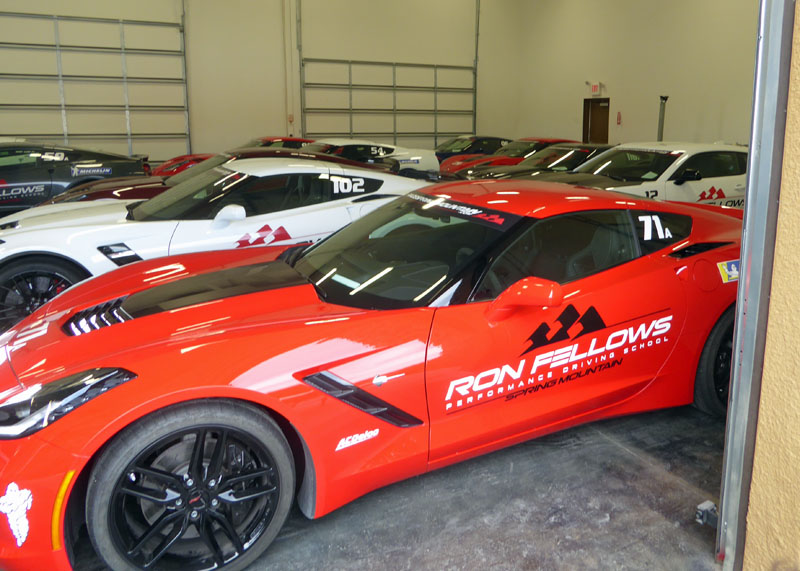
Since each student was provided a car similar to what he or she our class included one woman owned, as verified by the VIN, they needed to have enough on hand to seat everyone.
That includes my garden-variety 460 hp Stingray, the more track-ready Grand Sport, and the 650 hp supercharged Z06, each available with seven-speed manual or eight-speed automatic transmission. Actually, they didnt provide an exact duplicate for me. We all drove coupes convertibles would have to be equipped with a roll bar to be permitted on the track.
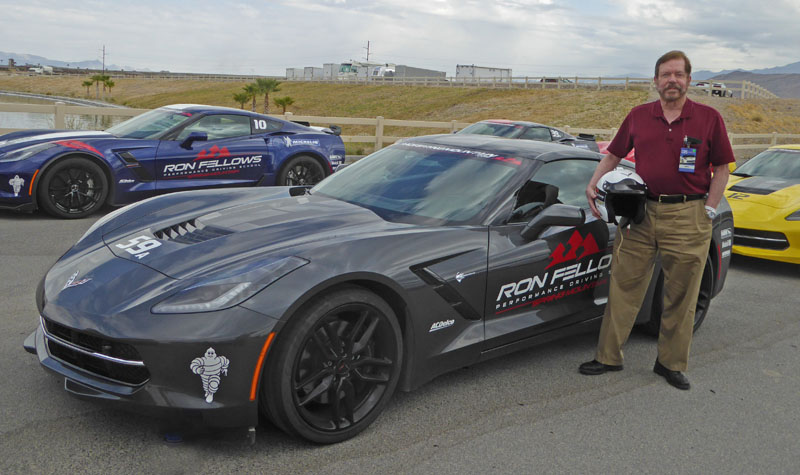
We also saw evidence that they are driven spiritedly! The Corvettes themselves are replaced at 10,000 miles.

The venue. As previously noted, the entire Spring Mountain race track is 6.1 miles in length, the longest in the US. After a planned further land acquisition it will be expanded to over 15 miles, even longer than Germany's famed Nόrburgring, currently the longest in the world.
Here's the layout of the entire track.
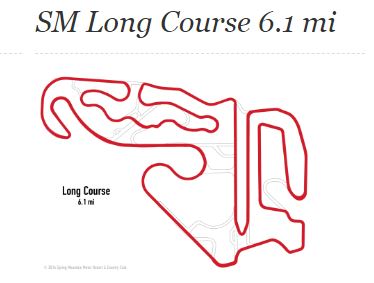
There is the capability to divide it into a variety of smaller tracks. For classes there are these three. (Gilles Villenueve was a champion Grand Prix race car driver in the late 70s and early 80s.)

Each has an adjacent classroom, garage, and a "paddock" where we'd saddle up beforehand and dismount afterwards. The Villenueve and East Courses included a large area to accommodate various automotive exercises, which the West course shared with the Villenueve Course. We were assigned the East Course.
Classes. Two-day Corvette Owners classes are scheduled year round, except for special occasions, on Monday-Tuesday, Wednesday-Thursday, and Friday-Saturday. Although they are less popular during the summer and winter months, they currently had future reservations for 500, as well as a waiting list.
Actually, one didn't have to be a Corvette owner to take the class, in fact there was one student who didn't have one but had won attendance in an online contest in association with a televised Barrett-Jackson Collector Car auction.
Although there are three tracks available, the scheduling is not that simple they also have one- and three-day classes, occasional two-day classes for V-Series Cadillacs, and one track has to be available for members five days a week.
Class size in the two-day Corvette-owners class is limited to 20 students.Our class was one of two being held Monday and Tuesday, April 30-May 1, concurrent with a Monday private class and the beginning of a Cadillac class on Tuesday.
The instructor scheduling is equally complex, since Director Rick Malone can't be everywhere at once. Depending on how many classes are in session as many as three he provides the introductory lecture, the launch control video presentation (see later), or the graduation awards.
Spouses were welcome to attend the classroom meetings and could view the driving events from a lookout tower. A few did attend, including Betty Lou and the husband of the female student. The brochure had advised that spouses could avail themselves of all the amenities of the country club "24- hour fitness center, on-site massage, swimming pool and Jacuzzi, racquetball court, and our newest addition, Lake Spring Mountain, where you can experience water jetpack flights and paddleboarding" and perhaps some were taking advantage of them. However, the temperature was cool enough that we saw only one Sea-Doo-er, in a wetsuit, zooming around for a while, perhaps just performing for our benefit.
There were many real enthusiasts there, including a former drag racer and a motorcycle racer. Some had previously attended one was there for the third time! Others owned older model Corvettes, and therefore were not able to take advantage of the two-thirds subsidy that Chevrolet provided for owners who had purchased a new Corvette within a year. The $2,500 tuition cost alone indicated their level of interest.
The instructors. Altogether Rick has a staff of 32 instructors, all professional racing drivers, four of whom are qualified to fill in for him at the other venues as necessary. There were 10 at each venue -- that is, a 2-to 1 student to instructor ratio, and they needed more qualifications than driving ability: good communication skills and not just for those who taught various classes as well as multitasking abilities, as described later.
The curriculum. The course consisted of classroom instruction alternating with driving exercises and, of course, track time.
Classroom Instruction. It began with correct seating – it's a lot closer to the steering wheel than you might think. There are two reasons: the farther extended the arms are, the more quickly they will tire over the course of a race, and being closer to the brake pedal provides more leverage for the constant braking required.
Next was correct hand position. Of course, most knew the 9 o'clock - 3 o'clock placement, but it was a surprise to learn that the combination of quick steering ratio and the arc using the whole track means that the hands' change in position rarely exceeds ninety degrees. No steering wheel shuffling required.
With the basics out of the way, we began with the theory and dynamics of how to approach a corner. Everyone wants to accelerate, they said, but pointed out that it was only the eighth step!
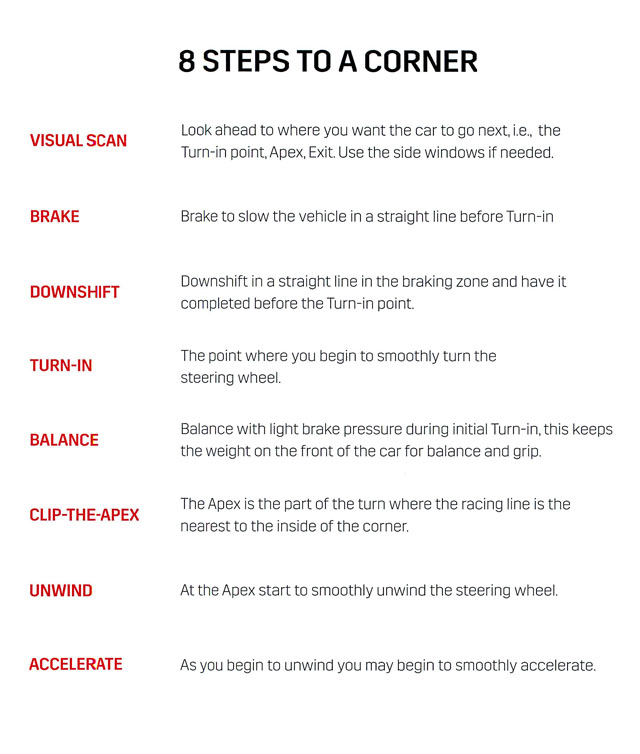
An instructor described and diagrammed each step of an example on a white board. Unfortunately they had forgotten to distribute this very useful diagram,
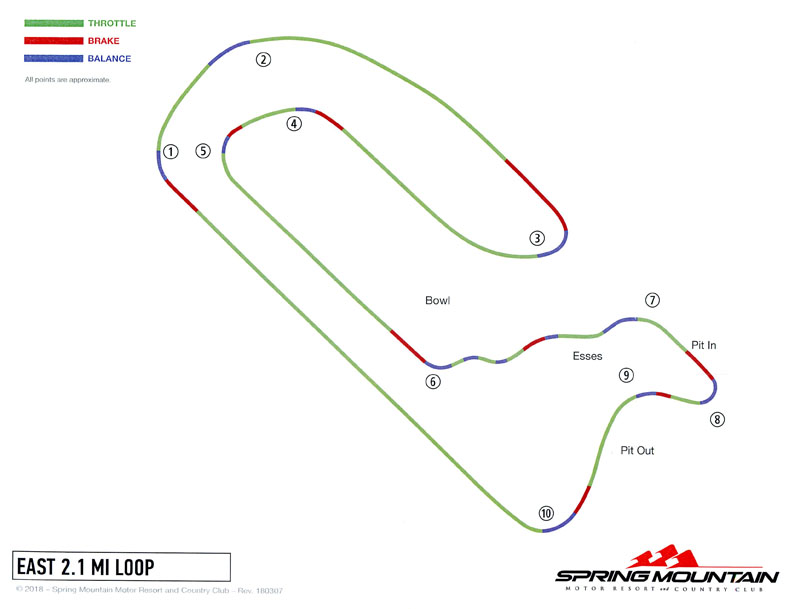
that Betty Lou discovered a in a corner of the classroom on the afternoon of the second day, that graphically indicated where to brake, balance, and accelerate at each corner where wed be driving. We learned that it was an oversight they were normally distributed during the first day.
To obtain maximum speed, in areas approaching corners one needed to use the entire track. Of course, overenthusiastic drivers might misjudge the correct speed and put wheels off the track, eventually causing ruts. To prevent this, sloped concrete curbing, striped red and white, is installed along the entry, apex, and exit areas.
I later learned that although it was generally not recommended to run up on the entry curbing, which could throw off the desired setup line through the curve, it was encouraged to hit the apex curbing as high as one could control. The exit curbing was less important one way or the other.
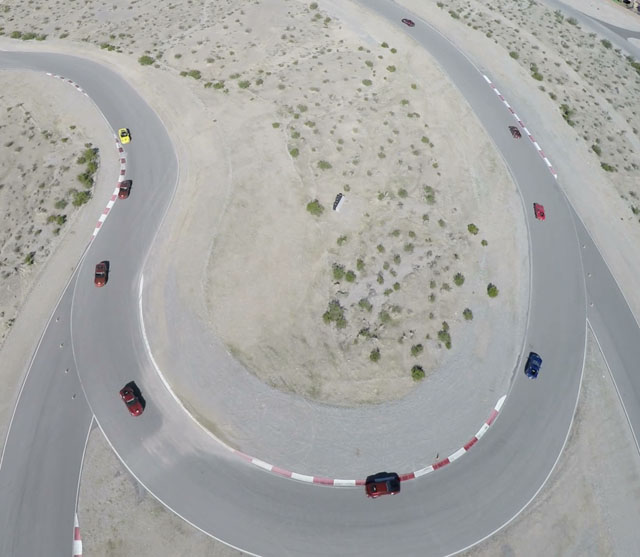
You can see these cars following the recommendations. For our track time, cones were positioned at the three curbing locations that would result in the quickest time around the curve.
Other classroom sessions included
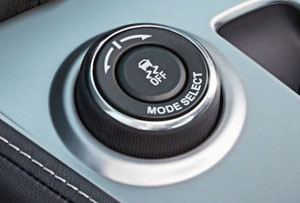
Driving Exercises. Some classroom sessions were for all 20, while others were for 10 when the other group was driving, which in addition to track time included exercises designed to sharpen skills useful not only on the race track but in everyday driving as well.
Track
Everyday
Track Time. Of course what everyone was waiting for was hitting the race track. We each had a few trips the first day and significantly more the second.
The track wasn't long enough to space out all 20 of us at once, so we were divided into two groups of 10 each. When our time came, three instructors would lead a line of three or four cars onto the track, spacing the groups out.
The first day the groups were chosen at random, the second it was by how aggressively the students drove, as determined by instructors' observations during the first day's trials. To avoid embarrassment, they didn't label the groups, but I'm fairly certain I wasn't in the one with Mario Andretti.
The first student in each group had the best view of the instructor's speed, the line he took, and when and how strongly he braked. Actually, the speed was up to how fast the lead student felt comfortable driving. If he approached closer, the instructor would speed up there was little likelihood it would ever be faster than he could drive! After two laps the first car would be directed by radio to pull over and join the end of the line while the others moved up.
The communication and multitasking skills previously mentioned came fully into play here. While leading us around the track, perhaps at increasing speeds, and like us, braking and shifting before, and shifting after, each corner, each had a radio in hand to contact the following ducklings, viewing us all in the rearview mirror and providing advice by name "Jack, drive closer to the apex!" even though I might have been two or three cars back. However, I hadn't yet known that the best strategy was not just to get close, but to drive up on the curbing.
You realize that each time we changed positions the instructor had to remember who was in each new position and he would be leading a different group the next time. With another radio he also was in contact with the other instructors, which is how he learned to lead us off the course when a car in another group went off the track. Also, occasionally one group would be slower than another and would be asked to pull off to the side so the faster group could go by. At different times we were in each group.
Betty Lou was able to ride along with an instructor during many of my sessions, and by the end I'm sure she knew better about how to manage the course than I did! She said that after the classroom sessions and the track time with an instructor, she was ready to go. She mimicked each instructor's actions with her imaginary controls, turning her steering wheel, hitting the brake and accelerator and shifting as he did. She said that taking the corners was particularly exhilarating. In fact, several instructors said she was ready to go!
Unfortunately, General Motors would only subsidize the Corvette owner, and she said we didn't need another one!
Students later had the opportunity to ride with an instructor who drove a lap at 70% maximum speed, so I was able to get an idea of her experience. However, although my ride was faster than hers, it was only one lap, and she was able to observe at least six or eight laps each time.
My lap was very instructive, including hitting the apex curbing hard, but it would have been more useful to have experienced it earlier. By the way, the lap record for the entire course is held, appropriately enough, by Ron Fellows.
All cars were equipped with Performance Data Recorders, so later analysis of our SD cards could reveal our improvement with time – and the gap remaining between us and an expert!
At the end of the course and we all survived they asked us for our observations and our motivation for taking it. Most commented on the amazing amount of information they could impart in two days and the expertise and equanimity of the instructors. I commented that I was now even more impressed at the skill level required to drive smoothly and rapidly on a track and even more so by those who do so among a pack of other drivers similarly motivated.
Also, that no matter how many stupid things we did, the instructors only just gently corrected us!
Some had signed up to see what their Corvette would be capable of, while others, including those who had previously attended, wanted to improve their driving skills. I said although I probably would not be on a race track again, I just thought it would be a cool thing to do and it was!
However, what brought down the house was one who said he had bought a Corvette to attract women, but that didn't work, so he decided to take the driving course!
The rain stopped long enough to pose for a class photo.

1Fortunately, the captain had treated us to an aerial view of Grand Canyon on our incoming flight.

